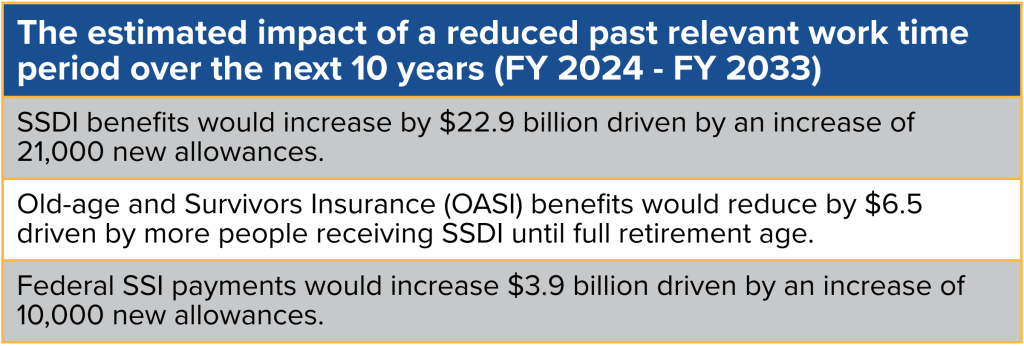At the end of last year, the Social Security Administration announced a proposed change to the time period to be considered when deciding if a claimant’s past work is relevant when making a disability determination. It was a rare claimant-friendly proposal that saw Social Security suggest reducing the past relevant work (PRW) period from fifteen years to five years. Last week, Social Security finalized the proposal, moving the regulation forward in the Federal Register, officially reducing the past relevant work period to five years. In addition, Social Security will not consider any past work that started and stopped within 30 calendar days. These changes are expected to have a significant and positive impact on those applying for Social Security Disability and Supplemental Security Income benefits.
How past relevant work factors into a disability determination
Social Security uses a 5-step sequential evaluation process to determine if a claimant meets the strict standards to qualify for disability benefits. At Step 4 of the sequential evaluation process, Social Security reviews a claimant’s past relevant work and determines whether, in combination with their residual functional capacity – the ability to perform work-related activities despite their impairments – that past relevant work could be performed today. Past relevant work is taken into consideration again at Step 5, when it is combined with the claimant’s residual functional capacity, as well as their age and education level, to determine if any work available in the national economy can be performed.
Let’s suppose John, age 52, became disabled while working at his medium to heavy physical exertional level job that he has worked at for the past 13 years. Prior to joining this company, John worked in an office for a few years doing sedentary work. While he hasn’t worked at this office job in more than 13 years, under the current 15-year rule, if Social Security now determines that John is capable of sedentary work, his claim could be denied at Step 4 of the sequential evaluation process. However, with the rule change reducing the past relevant work look-back period to just five years, Social Security cannot consider whether John is capable of performing the sedentary job he had more than 13 years ago. This change also means that at Step 5 of the sequential evaluation process, Social Security can only consider John’s work for the past five years when Social Security is trying to determine if John has any transferable skills that would allow him to perform any other work.
A modern take on past relevant work
Recognizing that changes occur within a modern workforce, the reduction in the past relevant work time period reflects Social Security’s understanding of how work skills diminish over time when not practiced regularly, and what was once relevant work is no longer defined as such. With the new ruling, Social Security redefines past relevant work as “work that you have done within the past five years that was substantial gainful activity and that lasted long enough for you to learn to do it. We will not consider work to be past relevant work if you started and stopped it in fewer than 30 calendar days.” This change allows applicants to focus on more recent work responsibilities, provide more accurate and detailed information, and reduce the burden of providing past work information that may not be readily available.
The expected impact on the disability application process
Social Security has announced that this rule will go into effect on June 8, 2024. This rule will apply to all claims awaiting a final decision or determination, in addition to any newly filed claims. Social Security expects this change to “achieve several goals” and significantly impact four areas within the disability determination process.
- More meaningful work history reports: Social Security must rely on claimants to provide information about their past work, including duties, time spent on tasks and more. With less of a time period to cover, information is more likely to be detailed and accurate, requiring less follow-up from Social Security staff.
- Better accounting for diminishing relevance of work skills: Recent evidence suggests that work skills and job requirements become outdated more quickly than previously thought. This shorter time period takes this into consideration.
- Reduce processing time and improve customer service: With more accurate and detailed information provided at the time of the initial application, decisions can be made more quickly, improving customer service experiences that have been dwindling as of late.
- Ease the burden on the claimant: Under current rules, claimants must provide evidence of all their work experience fifteen years from their date of disability. In some instances, information may not be readily available, or there may be a lot of information to gather. Shifting the requirement to five years significantly reduces the burden of collecting required information.
Before publishing their proposal, Social Security conducted a case study of disability decisions to determine the impact of reducing the past relevant work time period to support the proposal. The analysis revealed several exciting developments, including a significant increase in the expected number of disability approvals.

While we must wait until the proposal is implemented to see exactly how large of an impact this change will have, it is clear there that it will have a positive effect, and we welcome it. It is encouraging to see Social Security enact positive change and work toward making its processes much more customer-friendly. As always, Brown & Brown Absence Services Group will monitor this change closely and will report any updates related to this and other Social Security matters. We encourage you to contact us directly should you have any questions about this exciting update.




